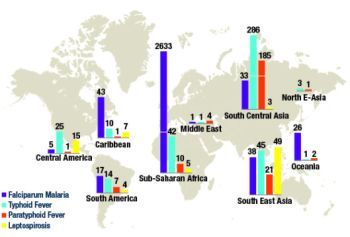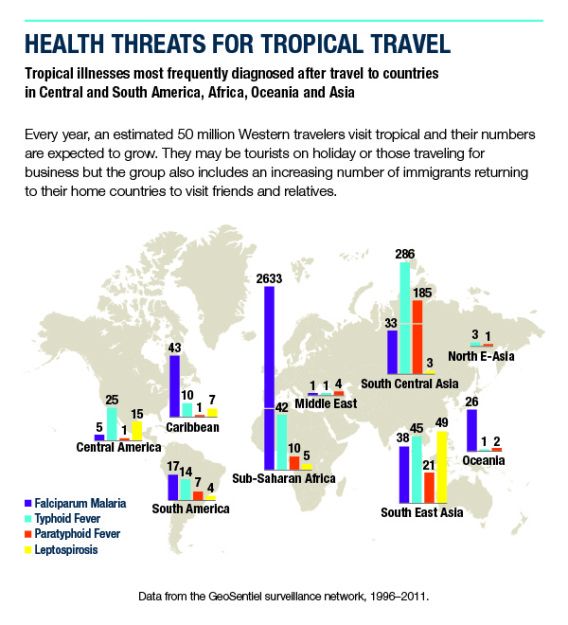
Publisher:
Bonnie King
CONTACT:
Newsroom@Salem-news.com
Advertising:
Adsales@Salem-news.com

~Truth~
~Justice~
~Peace~
TJP
Jan-17-2013 11:32

 TweetFollow @OregonNews
TweetFollow @OregonNews
New Study Finds Malaria, Typhoid Fever - Not Ebola Virus - Are the Biggest Health Threats for Travelers to the Tropics
Salem-News.comMalaria—caused by a parasite spread by the bite of infected female mosquitoes—was by far the most common condition, making up 76.9 percent of the diagnoses.
 Visit http://bit.ly/UWGHW3 |
(DEERFIELD, IL) - Feeling feverish after a visit to the tropics? It may not just be a bout with this year’s flu. If you’re a Western traveler, malaria and typhoid fever should top the list of diseases to discuss with your doctor when you return, especially following travel to Western Africa or India.
In a study of more than 80,000 returned travelers who sought medical care for illnesses, around 3,000 (4 percent) were affected by malaria, typhoid fever and other potentially life-threatening tropical diseases. Many would be surprised to know that not a single traveler contracted the highly contagious and lethal Ebola virus, which is typically one of the tropical diseases most feared by travelers. The findings were published online today in the American Journal of Tropical Medicine and Hygiene.
“While diagnosis and treatment of malaria and typhoid fever and many other tropical diseases have improved greatly over the years, people still can die from them if they are not treated quickly after their symptoms begin,” said University of Oslo researcher Mogens Jensenius, MD, PhD, who with his colleagues analyzed 15 years of data entered into the GeoSentinel surveillance network database. “Doctors and nurses in Western countries need to be vigilant in considering these potentially life-threatening tropical infections in recently-returned travelers with fevers, and identify and treat them quickly.”
Jensenius and fellow researchers at the U.S. Centers for Disease Control and Prevention (CDC), and several other universities throughout Europe, Israel, Australia and the United States looked at data from 82,825 ill travelers from Europe, North America, Israel, Japan, Australia and New Zealand. The travelers sought care at clinics associated with GeoSentinel from June 1996 through August 2011 with illnesses contracted during travel to the tropics.
They found that 3,655 patients—4.4 percent of the total—had one of 13 life-threatening diseases. There were a total of 13 deaths, 10 of which occurred in patients with malaria.

Of the diseases, the researchers found:
- Malaria—caused by a parasite spread by the bite of infected female mosquitoes—was by far the most common condition, making up 76.9 percent of the diagnoses
- Fevers such as typhoid fever—a potentially life-threatening bacterial infection contracted from contaminated food and water in areas with poor sanitation—were found in 18.1 percent of the patients
- Leptospirosis, the rare bacterial infection, which is usually caused by exposure to contaminated water, was diagnosed in 2.4 percent of the ill travelers
Malaria was mostly seen in travelers to West Africa, while most cases of typhoid fever were contracted by visitors to the Indian subcontinent. There were no cases of Ebola, Lassa fever or yellow fever among the more than 82,000 ill Western travelers included in the study, according to Jensenius and his fellow researchers.
We were quite surprised that these much-feared viral infectious diseases were completely absent,” said Jensenius, who is also an infectious disease physician at Oslo University Hospital. “People talk about them all the time, but our paper suggests that these are still very, very rare among travelers.”
European clinics reported more than half of all of the life-threatening diagnoses. Jensenius said this may reflect the fact that most European (as well as New Zealand and Australian) GeoSentinel sites are located in hospitals whereas sites in the United States and Canada more often are travelers’ clinics. “In many of the North American GeoSentinel sites, they are more focused on pre-travel care,” he noted, “and don’t see as many patients post-travel as we do in Europe.”
Every year, an estimated 50 million Western travelers visit tropical countries in Central and South America, Africa, Oceania and Asia, and their numbers are expected to grow, according to the World Tourism Organization (UNWTO). They may be tourists, adventure or eco-travelers on holiday or those traveling for business. But the group also includes an increasing number of immigrants returning to their home countries to visit friends and relatives.
“While tropical illnesses are rare in the Western world, these findings remind us that infectious disease pays no attention to geographic borders and affects the world at large,” said David H. Walker, MD, president of the American Society of Tropical Medicine and Hygiene and chair of the department of pathology at the University of Texas Medical Branch in Galveston. ““Our membership includes an exceptional cadre of skilled physician-scientists who are civilian, military and governmental clinical experts in travelers' health and diagnosing and treating tropical infection and disease. It is noteworthy that three of the leading life-threatening diseases are neglected rickettsioses, scrub typhus, murine typhus, and spotted fever rickettsioses.” (For a list of physicians who specialize in Tropical Medicine, Medical Parasitology and Travelers' Health, go to: http://www.astmh.org/source/
Each year, thousands of ill travelers seek health care at one of the 57 clinics associated with Geosentinel around the world when they return from their visits. Their anonymous diagnoses are uploaded to GeoSentinel’s database to track disease trends among travelers. The GeoSentinel network was initiated in 1995 by the International Society of Travel Medicine (ISTM), and is funded by ISTM and the U.S. Centers for Disease Control and Prevention to track travel-related illnesses and deaths.
Researchers have published more than 20 studies using GeoSentinel data, but the new study focuses only on tropical travel and “the life-threatening conditions that we as physicians need to identify rapidly,” Jensenius said.
Travel Advice for Returning Immigrants and Western Travelers
Many of the malaria cases seen in the study were in immigrants returning to their countries of origin to visit friends and relatives, the researchers discovered. Jensenius said these travelers may have battled malaria when they once lived in the tropics, and “have this misconception that they are immune to the disease.”
“When they go back from Europe 10 years later, they believe they don’t need the protection of a prophylaxis,” he said. “But that’s wrong.”
Similar misconceptions might occur among returning immigrants to the Indian subcontinent, who believe they have immunity against typhoid fever.
The researchers advise all visitors to tropical regions to seek pre-travel advice on vaccinations and medications required for the countries they plan to visit, and while traveling take precautions to prevent insect bites, and drink bottled water.
Travelers who become ill with fever or flu-like illness while traveling or soon after returning home from high-risk areas should seek immediate medical attention and share their travel history with their physician, Jensensius cautioned. “Nearly all the diseases identified in our paper presented with a fever and an incubation period of just a couple of weeks.”
For more information and links to key travel medicine websites go to ASTMH Travel Medicine Resources: http://bit.ly/UWGHW3
About the American Society of Tropical Medicine and Hygiene
ASTMH, founded in 1903, is a worldwide organization of scientists, clinicians and program professionals whose mission is to promote global health through the prevention and control of infectious and other diseases that disproportionately afflict the global poor.
About the American Journal of Tropical Medicine and Hygiene
Continuously published since 1921, AJTMH is the peer-reviewed journal of the American Society of Tropical Medicine and Hygiene, and the world's leading voice in the fields of tropical medicine and global health. AJTMH disseminates new knowledge in fundamental, translational, clinical and public health sciences focusing on improving global health.
 |
 |
 |
Articles for January 16, 2013 | Articles for January 17, 2013 | Articles for January 18, 2013
Quick Links
DINING
Willamette UniversityGoudy Commons Cafe
Dine on the Queen
Willamette Queen Sternwheeler
MUST SEE SALEM
Oregon Capitol ToursCapitol History Gateway
Willamette River Ride
Willamette Queen Sternwheeler
Historic Home Tours:
Deepwood Museum
The Bush House
Gaiety Hollow Garden
AUCTIONS - APPRAISALS
Auction Masters & AppraisalsCONSTRUCTION SERVICES
Roofing and ContractingSheridan, Ore.
ONLINE SHOPPING
Special Occasion DressesAdvertise with Salem-News
Contact:AdSales@Salem-News.com



Salem-News.com:

Terms of Service | Privacy Policy
All comments and messages are approved by people and self promotional links or unacceptable comments are denied.
[Return to Top]
©2025 Salem-News.com. All opinions expressed in this article are those of the author and do not necessarily reflect those of Salem-News.com.